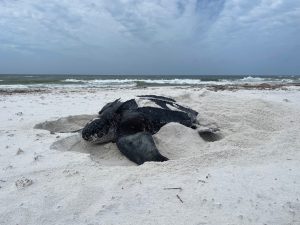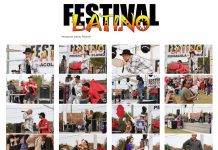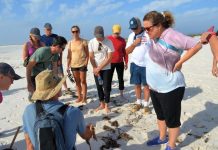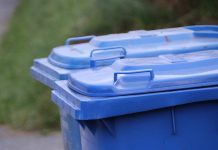La temporada de anidación de tortugas marinas comienza 1 de mayo
Los voluntarios del Programa de Conservación de Tortugas Marinas del Condado de Escambia comienzan sus días temprano a la primera luz del día para buscar signos de actividad de anidación tanto en Pensacola Beach como en Perdido Key. Los censos diarios aseguran que todos los nidos depositados durante la noche estén protegidos y marcados, lo que permite que continúen las actividades normales en la playa. Los voluntarios y el personal continuarán revisando los nidos durante el período de incubación, asegurándose de que no se les moleste y estén listos para ayudar con los varamientos y otros incidentes relacionados con las tortugas. La temporada de anidación durará hasta septiembre, aunque los nidos de finales de temporada pueden eclosionar hasta octubre.
Cuatro especies de tortugas marinas anidan en las playas locales. Las tortugas caguama y verde son las que anidan con mayor frecuencia, seguidas por la tortuga lora y la tortuga laúd, que son menos comunes. Las tortugas hembra llegarán a nuestras playas a principios del verano y pueden anidar varias veces en una sola temporada. Después de 60 días de incubación, las diminutas tortugas recién nacidas emergerán todas a la vez al amparo de la oscuridad y correrán hacia el Golfo de México. Las crías llegarán a aguas abiertas con menos depredadores. Después de algunos años de crecimiento y alimentación, regresarán al área como juveniles y subadultos. Aquí, continuarán creciendo y alimentándose hasta que estén lo suficientemente maduras para aparearse y poner sus nidos.
Las tortugas marinas jóvenes y adultas a menudo se pueden ver alimentándose en nuestras bahías y estrecho, incluso cerca de los muelles de pesca locales y los arrecifes artificiales.
Sin embargo, las tortugas marinas no son los únicos visitantes de verano. Varias especies de aves playeras anidan en las playas locales en los meses de verano, incluido el charrán mínimo, el chorlito nevado y la rayadora negra. Los nidos de aves playeras son raspaduras poco profundas en la arena con huevos diminutos y bien camuflados. Los huevos se incubarán unos 30 días antes de que nazcan los pequeños polluelos con forma de bola de algodón. Los padres a menudo se sientan en los huevos con los pollitos recién nacidos para protegerlos de los depredadores y del cálido sol de Florida. Tenga en cuenta que las personas y las mascotas que se acercan demasiado molestan a las aves.
Además, el verano es una temporada turística muy concurrida y las grandes multitudes pueden tener un impacto significativo en las tortugas marinas, las aves playeras y otros animales salvajes costeros.
Ayude a proteger nuestra fauna costera recordando:
Luces apagadas: Las luces brillantes pueden molestar a las tortugas marinas que anidan y desorientar a los adultos y crías en la playa. Cuando visite la playa después del anochecer, mantenga los teléfonos celulares y las linternas apagados. ¡En su lugar, use una linterna roja o ninguna luz! Para casas frente al mar, apague las luces exteriores cuando no estén en uso y mantenga las persianas y cortinas cerradas después del atardecer.
Deje solo huellas: ayude a mantener nuestras playas libres de obstáculos para las tortugas que anidan y crían. Todos los artículos personales, incluyendo sillas, tiendas de campaña, sombrillas, juguetes y equipos acuáticos, deben retirarse de la playa antes del atardecer todos los días. Asegúrese de rellenar los agujeros y aplanar los castillos de arena.
Comparta la playa: manténgase alejado de las áreas de anidación señaladas y evite colocar pertenencias en los bordes de las áreas marcadas. Evite molestar a las aves que descansan en la playa; si ve una tortuga marina anidando, ¡dele espacio! No manipule huevos y crías de tortugas marinas o aves playeras. Los perros solo están permitidos en los parques para perros designados en la playa y siempre deben estar atados.
Sea Turtle Nesting Season starts May 1
 Escambia County Sea Turtle Conservation Program volunteers start their days early at first light to look for signs of nesting activity on both Pensacola Beach and Perdido Key. Daily surveys ensure any nests laid at night are protected and marked, allowing normal beach activities to continue. Volunteers and staff will continue to check on nests during the incubation period, ensuring they remain undisturbed and are on standby to assist with strandings and other turtle-related incidents. The nesting season will run through September, although late-season nests can hatch as late as October.
Escambia County Sea Turtle Conservation Program volunteers start their days early at first light to look for signs of nesting activity on both Pensacola Beach and Perdido Key. Daily surveys ensure any nests laid at night are protected and marked, allowing normal beach activities to continue. Volunteers and staff will continue to check on nests during the incubation period, ensuring they remain undisturbed and are on standby to assist with strandings and other turtle-related incidents. The nesting season will run through September, although late-season nests can hatch as late as October.
Four species of sea turtles nest in local beaches. The loggerhead and green sea turtles are the most common nesters, followed by the less common Kemp’s ridley and leatherback. Female turtles will make their way onto our beaches through early summer and may nest several times in a single season. After 60 days of incubation, the tiny hatchling turtles will emerge all at once under cover of darkness and race to the Gulf of Mexico. The hatchlings will make their way to open water with fewer predators. After a few years of growing and feeding, they will return to the area as juveniles and sub-adults. Here, they will continue to grow and feed until they are mature enough to mate and lay their nests.
Juvenile and adult sea turtles can often be seen foraging in our bays and sounds, including near local fishing piers and artificial reefs.
However, sea turtles aren’t the only summertime visitors. Several species of shorebirds nest on local beaches in the summer months, including the least tern, snowy plover and black skimmer. Shorebird nests are shallow scrapes in the sand with tiny, well-camouflaged eggs. Eggs will incubate up to 30 days before the small, cotton ball-like chicks hatch. Parents often sit on the eggs with newly hatched chicks to protect them from predators and the hot Florida sun. Keep in mind that people and pets approaching too close disturb birds.
In addition, summer is a busy tourist season, and big crowds can have significant impacts on sea turtles, shorebirds, and other coastal wildlife.
Help Protect Our Coastal Wildlife by Remembering:
Lights Out: Bright lights can disturb nesting sea turtles and disorient adults and hatchlings on the beach. When visiting the beach after dark, keep cell phones and flashlights off. Instead, use a red flashlight or no light at all! For beachfront homes, turn off exterior lights when not in use and keep blinds and curtains shut after sunset.
Leave Only Footprints: Help keep our beaches obstacle-free for nesting and hatchling turtles. All personal items, including chairs, tents, umbrellas, toys, and water equipment, must be removed from the beach by sunset each day. Make sure to fill in holes and flatten any sandcastles.
Share the Beach: Stay out of posted nesting areas and avoid setting up belongings on the edges of marked areas. Avoid disturbing birds resting on the beach; if you see a nesting sea turtle, give it space! Do not handle sea turtle or shorebird eggs and hatchlings. Dogs are only allowed in designated beach dog parks and must always be kept on a leash.

















